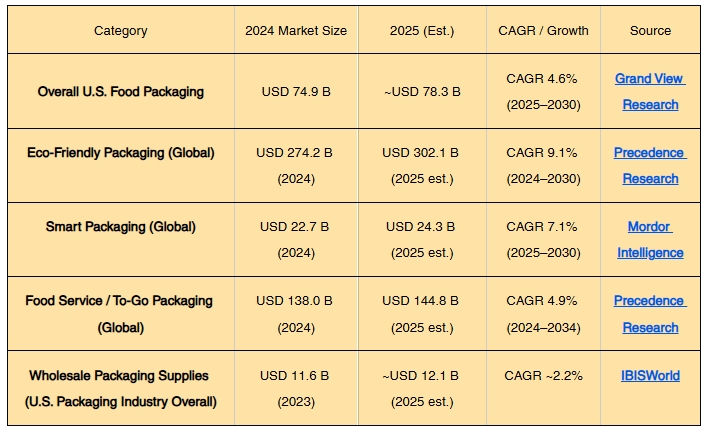Top Trends in Food Packaging Supplies You Need to Know in 2025
- abel zhao
- Sep 29
- 3 min read
Updated: Oct 24
Top Trends in Food Packaging Supplies You Need to Know in 2025

The U.S. food service industry has been through rapid change in the past few years, and food packaging supplies are evolving just as fast. Takeout, delivery, and eco-conscious dining are now the norm—not the exception. In 2025, the conversation isn’t only about convenience; it’s about sustainability, technology, and branding.
Whether you’re a restaurant owner, café manager, or wholesale buyer, staying ahead of these packaging trends can help you save costs, meet customer expectations, and build brand loyalty.
The Rise of Eco-Friendly Food Packaging Supplies

New Biodegradable Materials
Eco-friendly packaging is not new. But the materials are getting better. Besides common PLA plastics and sugarcane bagasse, there are now new options. These include wraps made from seaweed, trays made from mushrooms, and blends from recycled fibers. These new materials break down faster. They are also better for the environment. This helps restaurants meet the demand for greener packaging.
Compostable Packaging is Now Cheaper
A few years ago, compostable packaging was too expensive for small restaurants. This is no longer true. Because production has increased and certifications are updated, compostable items like cups and cutlery cost less now. This means food trucks and independent cafés can adopt them without hurting margins.
Innovations in To Go Packaging Food Service Supplies
Grease-Resistant, Leak-Proof, and Microwave-Safe
Consumers want takeout that travels well—no leaks, no soggy containers. In response, packaging suppliers are blending kraft paper with plant-based coatings that hold up against grease and moisture, while still being recyclable or compostable.
Smart Packaging for Freshness and Safety
Technology is stepping in to make food packaging smarter. QR codes that link to sourcing info, and time-temperature labels that track freshness, are becoming affordable for mid-sized food businesses. These solutions reduce food waste and build consumer trust.
Traditional vs. Smart Packaging in 2025

“According to ThomasNet, Meyers, and peer-reviewed scientific reviews.”
Insights from Food Packaging Suppliers
What U.S. Distributors Are Seeing
Distributors say demand for eco-certified products now makes up more than 60% of restaurant orders. Single-use plastics are on the decline, and buyers are looking for packaging that checks both boxes: functional and sustainable.
Key Insights on U.S. Food Packaging Supplies (2025)
Sources: ThomasNet | Meyers | Peer-reviewed Reviews

Union Supply Food Package Developments
The Meal Kit Effect
Meal kits are changing how food packaging is designed. Pre-portioned trays and sealed pouches that extend shelf life are in demand—not just for big meal kit companies but also for cafeterias, catering businesses, and even correctional facilities.
Customization and Branding
Plain white boxes are fading. Restaurants are choosing custom-printed and color-coded containers that tell a brand story. Some even use eco-friendly inks to align sustainability with branding.
Wholesale Food Packaging Supplies: What to Expect
Supply Chain Pressures Still Here
Rising costs of paper pulp and plant-based resins continue to challenge suppliers. But wholesalers are fighting back by building regional production and storage hubs, cutting down on shipping delays and costs.
Growth of Domestic Wholesale Markets
Instead of relying heavily on imports, more U.S.-based wholesalers are scaling up. California, Texas, and Illinois are now becoming key distribution centers, giving restaurants faster and cheaper access to packaging.
Data Snapshot: U.S. & Global Food Packaging Supplies Market 2025

FAQs on Food Packaging Supplies
Q1: What’s the most popular type of eco-friendly packaging right now?
Bagasse containers and compostable paper cups are still leading, but mushroom-based trays and seaweed films are on the rise.
Q2: Are smart packaging tools too expensive for small restaurants?Not anymore. Prices have dropped, and many suppliers now offer starter kits with freshness labels and scannable codes.
Q3: Where can U.S. restaurants find wholesale packaging?Alongside global suppliers, domestic hubs in California, Texas, and Illinois are becoming strong wholesale sources.
Q4: What’s driving the demand for union supply food packages?The growth of meal kits and ready-to-eat options has boosted demand for pre-portioned trays and customizable branded boxes.
Final Thoughts
In 2025, food packaging supplies are no longer just about holding food. They’re about communicating values, building trust, and keeping pace with consumer expectations. From eco-friendly innovations to smart labeling and wholesale restructuring, the market is moving quickly.
Restaurants and suppliers who embrace these changes now will be better positioned to win customer loyalty, cut costs, and stay competitive in the years ahead.
WhatsApp: +86 13867471335 Email: abel@mana-eco.com



Comments